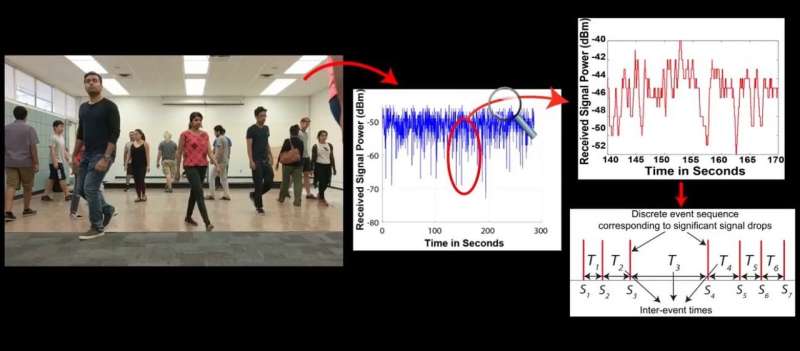Crowd counting through walls, with WiFi

Researchers in UC Santa Barbara professor Yasamin Mostofi's lab have given the first demonstration of crowd counting through walls using only everyday communication signals such as WiFi. The technique, which requires only a wireless transmitter and receiver outside the area of interest, could have a variety of applications, including smart energy management, retail business planning and security.
"Our proposed approach makes it possible to estimate the number of people inside a room from outside," said Mostofi, a professor of electrical and computer engineering at UC Santa Barbara. "This approach utilizes only WiFi RSSI measurements and does not rely on people to carry a device."
The proposed methodology and experimental results were presented at the 2018 IEEE 2018 15th Annual IEEE International Conference on Sensing, Communication, and Networking (SECON)
In the team's experiments, one WiFi transmitter and one WiFi receiver are behind walls, outside a room in which a number of people are present. The room can get very crowded with as many as 20 people zigzagging each other. The transmitter sends a wireless signal whose received signal strength (RSSI) is measured by the receiver. Using only such received signal power measurements, the receiver estimates how many people are inside the room—an estimate that closely matches the actual number. It is noteworthy that the researchers do not do any prior measurements or calibration in the area of interest; their approach has only a very short calibration phase that need not be done in the same area.
This development builds on previous work in the Mostofi Lab, which has pioneered sensing with everyday radio frequency signals such as WiFi, with several publications in this area since 2009. For instance, their 2015 paper showed crowd counting without relying on people to carry a device, but with the transmitter and receiver in the same area as the people.
"However, enabling through-wall crowd counting is considerably more challenging due to the high level of attenuation by the walls," said Mostofi. Her lab's success in this endeavor is due to the new proposed methodology they developed.
Key to this technology is that human presence and movement can result in significant drops—thought of in this project as "events"—in the received signal strength.
"Consider the event sequence that corresponds to the occurrence of significant signal drops," Mostofi said. "An inter-event time is then the time in between two consecutive events." The researchers' approach for enabling through-wall crowd counting is based on mathematically characterizing the information content of the received signal inter-event times, and relating it to the total number of occupants.
"We have observed that while the signal magnitude can be severely attenuated through walls, the inter-event times corresponding to the events of significant signal drops are more robust to wall attenuations," Said Saandeep Depatla, the lead Ph.D. student on this project. Thus, the researchers' approach is based on exploiting these inter-event times.
More specifically, by modeling the event sequence corresponding to the significant signal drops as a renewal-type process, the researchers have utilized mathematical tools from renewal process literature, a theoretical field that has found applications in areas such as reliability and risk analysis. After a long derivation, the researchers were able to mathematically model the statistics of the inter-event times and explicitly relate them to the total number of occupants in the area.
The Mostofi Lab has tested their new technology extensively, in different locations, with different wall properties and with several different numbers of people—up to and including 20. They showed a counting accuracy of 2 people or less 100 percent of the time with only one WiFi link. It is further noteworthy that their setup consists solely of off-the-shelf WiFi transceivers.
More information: Saandeep Depatla et al. Passive Crowd Speed Estimation and Head Counting Using WiFi, 2018 15th Annual IEEE International Conference on Sensing, Communication, and Networking (SECON) (2018). DOI: 10.1109/SAHCN.2018.8397119
More information about the project can be found at https://www.ece.ucsb.edu/~ymostofi/ThroughWallCrowdCounting.html
Additional information about Mostofi's research is available at http://www.ece.ucsb.edu/~ymostofi





















